
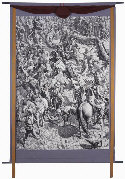
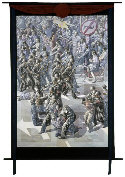
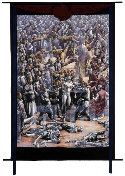
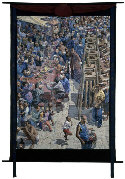
Decapitation Drawing & Quartering Firing Squad Flaying Starvation
Zhi Lin
Summer 2006
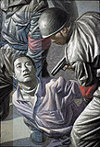
PC: You've been quoted in an article published by Creative Capital, which awarded you a grant, as saying that "in high school I recognized that my education was robbed by the Chinese Cultural Revolution and by Mao." Would you tell us more about that, what effect the Cultural Revolution had on your education then, and, perhaps, your drive for self-education and three MFA's?
ZL: I grew up in China during the Cultural Revolution. Forty years ago, this summer, the Chinese people began their ten-year-long nightmare. I remember that everyone could only wear clothes in two colors: green and blue with no designs or patterns. Women's hair had to be straight and shorter than the shoulder. Red Guards routinely tortured people in public -- they called the practice "to strangle people" - in reference to class strangle. In many places in China, nearly everything produced and made prior to the year 1949 would be destroyed. That list included everything from street signs to books, from clothes to paintings, from Buddhist statues to ancient temples (many temples and statues found in China today were rebuilt after 1978). In my family, nearly all the books were burned or thrown away, but the Red Guards still targeted my father. They "strangled" him; then he was sent to labor camp - in one of the many "May 7th Schools," for the next two years. That was my family. From 1966 to 1968, the whole nation was in a civil war. Different factions carried out fights daily on the street with firebombs, guns, and tanks. As a boy, I did not have to go to school, because it was shut down. Every morning I would stand on top of a roof of a house, and I would wait for the daily street fights.
That tumultuous ten-year period forced me to be constantly aware of the social and political climate in an effort to avoid political persecution. This kind of awareness made me become reflective and responsive to the environment in which I live. My work reflected that kind of sensitivity.
For a number of years, the entire school system in China was shut down (from grade schools to universities). When the schools reopened, they would not allow teachers to teach anything that had even a remote association with history and the West. Before I entered college in 1978, I recognized that the Cultural Revolution denied me, and a generation of Chinese, a fundamental education about Chinese history and civilization. Since then, I have been trying to catch up on what I have missed. I taught myself traditional Chinese calligraphy and painting; I traveled to nearly 20 of the 30 provinces in order to visit and study Buddhist caves and Daoist Temples, which housed the most important traditional Chinese sculptures and frescoes. However, even up to now, I still feel that I am trying to catch up with what I have missed from my education: the sense of history, and the tradition of our human experience, and the continuity of our cultures both in the East and West. Learning is a life-long journey. Tzu Hsia said, "learn widely and be steadfast in your purpose, inquire earnestly and reflect on what is at hand, and there is no need for you to look for benevolence elsewhere."
PC: You continued your studies in China, BFA at the China National Academy of Fine Arts. Hangzhou, China. Was it there that you developed your interest in the Buddhist frescoes in Dunhuang?
ZL: Yes.
PC: What drew you to this art?
ZL: In the early 1980's, while many of my classmates were looking for answers from the West and from today's art, I chose to search for my answers from traditional Chinese art.
PC: You also said in the Creative Capital interview, "in 1981, I went to Dunhang, on the Silk Road and spent three months studying and copying the frescoes in the caves in the middle of the desert." That was pretty far from where you were living and studying--and required a commitment. Would you tell us something about your experiences while you were there? How did you go about your work?
ZL: It was a part of the five-month study trip from April to August in 1981; it took me to many important sites in Chinese art history along the Yellow River, and the Yangtze River. Actually, I spent every single day of one month in the caves of Dunhang. The living condition was harsh; the work condition was equally unbearable. However, the excitement about the opportunity of studying the art in Dunhang really perpetuated my classmates and I to focus on our work. It was a truly inspiring, rewarding and exciting experience.
Traveling to and studying in Dunhang, in the National Academy, is always regarded as a pilgrimage to the Chinese tradition. The school was founded in 1928, as the National Arts Academy. The goals of the school were to introduce Western art, recognize Chinese art, synthesize Chinese and Western art, and create an art for the present epoch. From this time on, for many years, not only did Western art begin to acquire viability as a mode of artistic expression, but Chinese artists carried a sense of social responsibility and understood the importance of their work for China.
1
Studies and Details by Zhi Lin relating to the scrolls: "Five Capital Executions in China"
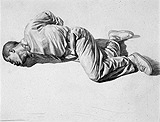
A tied up man on the ground, study for Firing Squad 1995 graphite on paper 8 x 11
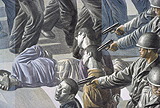
Firing Squad - Detail Gunned down man.
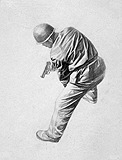
A man with a gun, study for Firing Squad 1995 graphite on paper 11 x 8
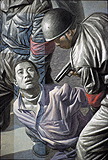
Firing Squad - Detail Center Figure.
